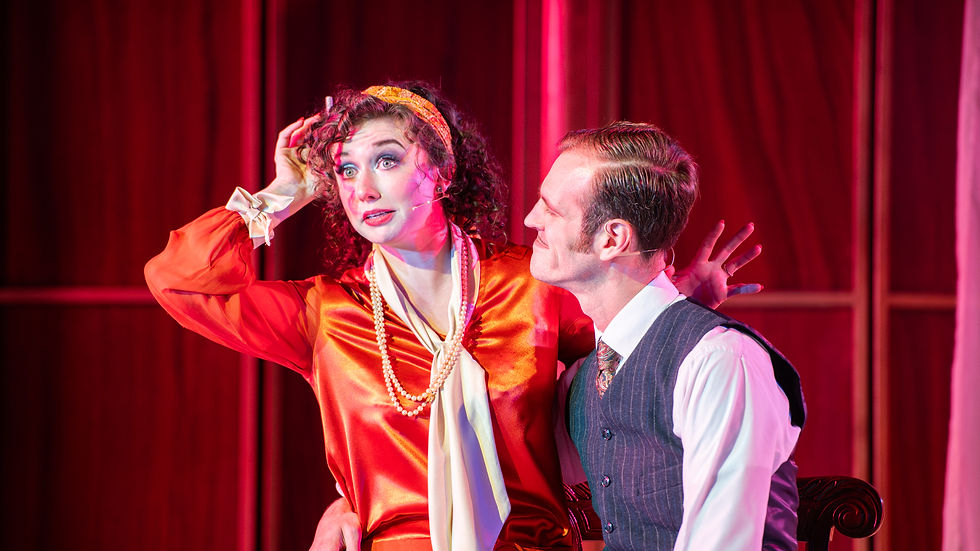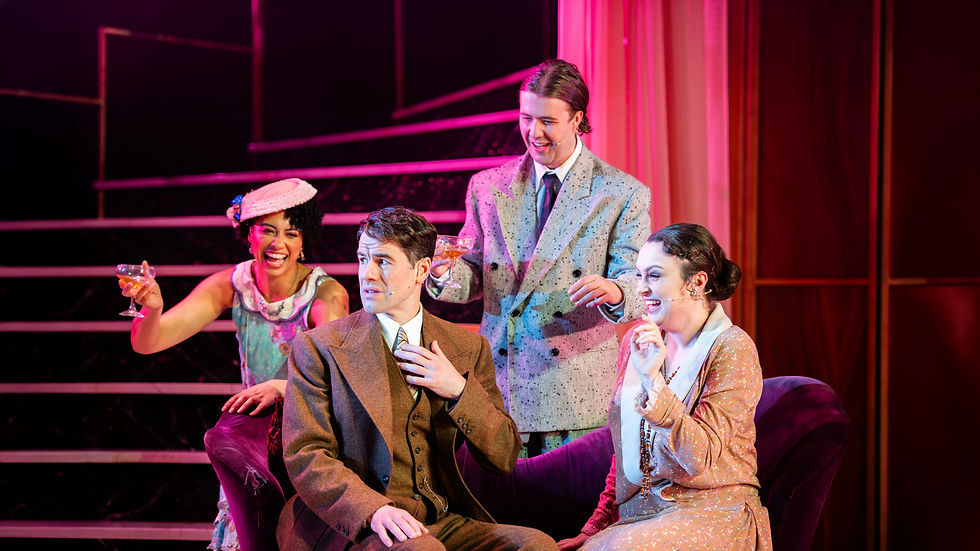The Great Gatsby - Derby Theatre Review
- Thomas Levi

- Oct 8
- 5 min read
★★★☆☆
If Gatsby himself were staging this, I imagine he’d insist on a sea of glittering lights, crystal chandeliers, and a champagne fountain. Here at Derby Theatre, co-producing Elizabeth Newman’s adaptation to mark both Fitzgerald’s 100th anniversary and Derby Theatre’s 50th year, we get something slightly leaner—but still bursting with ambition. This Great Gatsby is a spirited and enjoyable ride, full of clever ideas and emotional peaks. But can a middle-budget theatre evoke both the glamour and the tragedy of Gatsby’s world?

The Great Gatsby follows Jay Gatsby, an enigmatic, new-money millionaire in 1920s New York, whose lavish parties and mysterious wealth mask a single purpose: to rekindle his romance with Daisy, now married to the imposing figure of old money, Tom Buchanan. Narrated by Daisy’s cousin Nick Carraway, the play reveals Gatsby’s obsessive fixation on the past, the corruption beneath the façade of wealth, and the moral emptiness of the American Dream. As relationships unravel and illusions crumble, tragedy is an inevitable consequence.
One of the production’s greatest triumphs lies in its narrator, Nick Carraway, portrayed by David Rankine. Barely leaving the stage, Rankine anchors the performance as both the narrative driving force and its emotional heart. His portrayal captures Nick’s thoughtful honesty and observant nature, grounding the story’s chaos with moral clarity and emotional depth. Rankine creates a wholly believable Midwestern gentleman of the 1920s, a man through whose eyes we witness every fall from grace. His delivery brims with sincerity, making Nick not only the audience’s guide but also the production’s most human presence. It’s fair to say Rankine’s performance is the show’s greatest strength; he owns the stage from start to finish.
Another massive highlight is the live jazz band perched atop the sweeping staircase. The cast doubles as musicians, and this choice pays off: musical interludes don’t feel tacked on, but are an integral storytelling device. Under the musical direction of Shonagh Murray and choreography by Sasha Harrington, transitions breathe; dance and jazz music sequences allow us to witness the emotional subtext through lush audio-visual layering.

Jen McGinley’s set design deserves applause: The sweeping staircases and Art Deco detailing anchor the play in 1920s high society, while the ever-present thin net curtain becomes a striking motif, a gauze between illusion and reality, as well as a clever device for lighting effects and separation between Gatsby’s private world and the outside gaze. It’s a poetic choice that could have been pushed even further through projection or shadow work to heighten the sense of spectacle. Within the production’s limitations, McGinley’s design still manages to conjure elegance; one can easily imagine that, with limitless funds, chandeliers and gleaming surfaces would have filled the stage in Gatsby’s signature display of excess. The inclusion of simple tables, chairs, and even a car is essential for certain scenes, though the furnishings could have done more to comment on the new money opulence of Gatsby’s home versus the old money refinement of the Buchanans’.
Actor by actor, there are bright moments. Oraine Johnson’s Gatsby is earnest and notably less opulent and charismatic than other versions, which brings its own rewards and risks. He leans into the character’s idealism: the dreamer who builds mansions not just to show off, but in the hope that Daisy will walk through their doors. Johnson’s laid-back attitude toward wealth suggests the weight of his obsession rather than the glitter. That said, at times I found myself wishing for slightly more. I picture Gatsby as a larger-than-life character with grand dreams of wealth and love, and Johnson offers a more restrained and thoughtful interpretation: less myth, more the human behind it.
Jordan Baker is a character of half-smiles and sharp glances, and April Nerissa Hudson plays that well. She captures Jordan’s cynicism and her witty detachment. Hudson’s throwaway comments about love and money hit just the right note. The script sometimes sidelines her, using Jordan more as a narrative device, but Hudson ensures that whenever Jordan is on stage, you feel her presence.

Tom Buchanan is a character built to dominate a scene, and Tyler Collins more than rises to the occasion. From his first entrance, you sense an air of entitlement in his posture and the incredibly rich tone of his voice. Collins embodies a brutal man secure in social supremacy, yet insecure beneath the veneer. It is a stellar performance from Collins, managing to create a character who is both repellent and fascinating to watch.
Fiona Wood creates an interesting Daisy Buchanan, a woman who wants nothing more than luxury and security. She portrays the shallow, indecisive, and self-centred character well. However, where the performance stumbles is in the relationships: her chemistry with Gatsby sometimes feels courteous rather than electric, and you never quite see Daisy fully torn between Tom and Gatsby. That hesitation or disconnection makes some of Gatsby’s longing harder to feel intensely.
Where the writing in this adaptation falters is in its overuse of phrases and structural repetition. The phrases “Gatsby”, “Old Sport,” and “West Egg” were hammered home so often in the first act that they risked becoming echoes rather than meaningful markers. The script feels like someone with a microphone is repeating the same code words to ensure no listener misses the reference. Subtlety takes a backseat to emphasis.
A second issue is that, at times, the multi-role characters sometimes blur into one another. The voice, physicality, and costumes were not distinct enough to differentiate; I found myself occasionally re-orienting mid-scene. This lack of sharp separation disrupted the narrative flow.

Even among imperfections, certain moments rise to brilliance. Nick’s closing monologue, reflecting on memory and loss, feels poignant and raw. The slow-motion sequences are a staging gem: in them, you see multiple characters, their desires and contradictions laid bare. The moment Myrtle is struck by Gatsby’s car is truly gripping, and Gatsby’s tragic death is powerful. Even if the gun sound effect was bafflingly unrealistic. Similarly, Jen McGinley’s costume design echoes the era perfectly: it never distracts, but it sets the tone. The collaborative union between cast and creatives feels well-balanced, controlled, and well-suited for the show.
Derby Theatre’s The Great Gatsby captures much of the shimmer, heartbreak, and quiet tragedy that define Fitzgerald’s world. It may not dazzle with Gatsby-level grandeur, but what it offers instead is an intelligent, heartfelt interpretation focused on story, character, and atmosphere. The cast delivers honest, engaging performances — Nick’s integrity anchors the piece, Tom’s dominance commands attention, and the staging works hard to keep the energy alive throughout.
This production proves that you don’t need Hollywood-scale opulence to bring Gatsby’s world to life; you just need heart, imagination, and a little Jazz. If you fancy being swept into the glimmer of the 1920s and the timeless ache of the American Dream, Derby Theatre’s doors are open, and the green light is still shining.





















































Comments